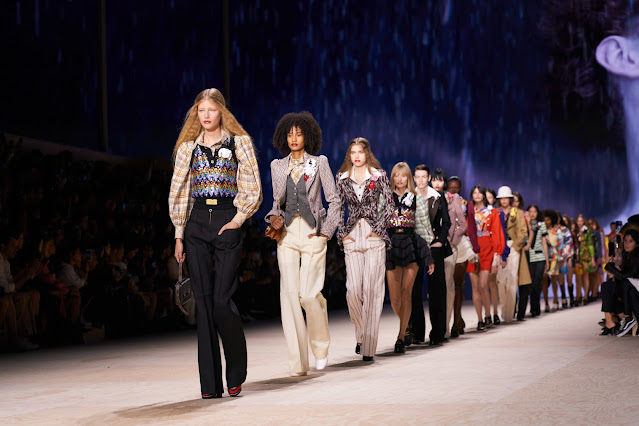The usage of clothing as an art form has birthed great designers and leading names in the industry like Coco Chanel, Elsa Schiaparelli, Chloe, Lanvin, Valentino, Mugler, Givenchy, Louis Vuitton, Vivienne Westwood, and many more. These designers have created fashion art at the highest level with great couture shows in different parts of the world and the continent of Europe. Clothing I would often refer to as "coverage or garment" used to shield or craft a personality you want the world to see, I believe clothing is a necessity but I am also learning that there's also the conversation of clothing wastage.
Why Sustainable Fashion?
photo retrieved from Google
the past few years has garnered a lot of attention towards what sustainable fashion is, since the rise of E-commerce and fast fashion, a lot of new brands like SHEIN, ASOS, FASHIONOVA, ZARA, Primark, H&M, new look, and many more that push fast fashion at a cheaper price still produce massively a large proportion of clothing in a year. An article written by Gad Allon for the business insider in 2022 highlighted "Every day, tens of millions of garments are tossed out to make way for new ones. And every year, 101 million tons of clothing end up in landfills. And the trend toward fast fashion — cheap, mass-produced items that chase short-term fads — are only making us more wasteful". Fast Fashion brands have continually produced large amounts of garments yearly resulting in mass wastage and adding to the environmental pollution of the earth.
Luxury fashion brands are not excluded from this issue but a larger percentage stems more from fast fashion brands. curbing wastage is a large conversation in environmental pollution, an updated statistic by the Geneva Environment Network shows "Fashion production makes up 10% of humanity’s carbon emissions, dries up water sources, and pollutes rivers and streams. What’s more, 85% of all textiles go to the dump each year (UNECE, 2018), and washing some types of clothes sends a significant amount of microplastics into the ocean". We as consumers play a large role in holding these companies accountable for their wastage and where this clothing is manufactured. These companies need to pay more attention to more sustainable raw materials and means of manufacturing as this helps also with the environmental impact of their high-functioning production sites emitting waste, Using Natural fabrics such as wool and cotton is more sustainable than synthetic ones.
Fashion Recycling
Is fashion recycling sustainable?. while trying to curb the conversation of wastage, recycling has become a conversation in the world. whether for things like plastic, paper, or other recycling options, the concept of reusing an item to create something helps to curb production wastage and reduce carbon footprint toward an eco-friendly environment. Business Insider quotes "A report by the Ellen MacArthur Foundation found that, globally, less than 1% of used clothing is actually recycled into new clothes. In contrast, 9% of plastic and about 70% of cardboard are recycled". consumers are constantly purchasing new clothing and a lot of our clothing is thrown into the garbage, the other pile is usually charity waste as major charities will still have a lot of unwanted clothing even after a drive which ends up in landfills. how can we incorporate fashion recycling into our ways of living and more importantly how can fashion brands be more intentional about recycling?. Even though it can be costly to recycle clothing, some businesses have found a way to recycle in order to reduce waste and this can be accounted as a step. companies like H&M in the past have used Recycling as a marketing ploy to improve brand image but a great percentage of the campaign did not go well. Holding firms and ourselves accountable, purchasing thrift and used items, and continually purchasing recycled items or items made from pure recycled items is a great step in the right direction.
Fashion Upcycling
photos retrieved from Google
fashion recycling has created room for upcycling in the industry, due to the large cost of recycling brands have turned toward reusing garments and fabrics to create newer styles. in 2020 an article published on the British Vogue digital site by Emily Chan highlights "Upcycling as the biggest trend in fashion right now". she quotes again "It’s no surprise that more designers are now embracing upcycling, considering the pandemic has led to an eye-watering €140 billion to €160 billion (£125 billion to £142 billion) worth of excess inventory from spring/summer 2020 collections – more than double the average. In the past, unsold goods would have been burned or thrown away by luxury brands in a bid to preserve their value, as part of a shocking practice that has since been banned in France. As customers become increasingly conscious of wasteful behaviour, it’s more essential than ever that the industry addresses this backlog of garments in a sustainable way".
Here's a list of fashion brands practicing upcycling;
- Patagonia
- Urban outfitters
- Beyond retro
- E.LV Denim
a lot of other luxury fashion brands like Balenciaga, Loewe, Miu Miu, and J.W Anderson have also incorporated this in their collections and presentations. upcycling is also prominent in online marketplaces like Etsy which allows a lot of merchants to sell upcycled items for customers to purchase.
If this is your first time hearing about these terms, I would be sharing more articles about where to shop with sustainability in mind and also fashion brands that have all of these terms into consideration during production. please share comments on your thoughts on this topic and any processes you have discovered in creating sustainable fashion.










1 Comments
Love the piece. Well written!
ReplyDelete